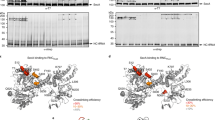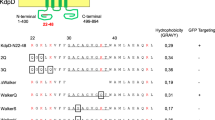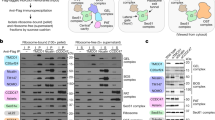Abstract
Ribosomes synthesizing inner membrane proteins in Escherichia coli are targeted to the translocon in the plasma membrane by the signal recognition particle (SRP) and the SRP receptor, FtsY. Here we show using a purified system that membrane targeting does not require an exposed signal-anchor sequence, as SRP-dependent targeting takes place with ribosomes containing short nascent peptides, with or without a signal-anchor sequence, within the peptide exit tunnel. Signaling from inside the tunnel involves ribosomal protein L23, which constitutes part of the SRP binding site. When nascent peptides emerge from the ribosome, the targeting complex is maintained with ribosomes exposing a signal-anchor sequence, whereas ribosomes exposing other sequences are released. These results indicate that ribosome–nascent chain complexes containing any nascent peptide within the exit tunnel can enter the SRP targeting pathway to be sorted at the membrane into ribosome-nascent chain complexes that synthesize either membrane or cytosolic proteins.
This is a preview of subscription content, access via your institution
Access options
Subscribe to this journal
Receive 12 print issues and online access
$189.00 per year
only $15.75 per issue
Buy this article
- Purchase on Springer Link
- Instant access to full article PDF
Prices may be subject to local taxes which are calculated during checkout





Similar content being viewed by others
References
Koch, H.G. et al. In vitro studies with purified components reveal signal recognition particle (SRP) and SecA/SecB as constituents of two independent protein-targeting pathways of Escherichia coli. Mol. Biol. Cell 10, 2163–2173 (1999).
Ulbrandt, N.D., Newitt, J.A. & Bernstein, H.D. The E. coli signal recognition particle is required for the insertion of a subset of inner membrane proteins. Cell 88, 187–196 (1997).
MacFarlane, J. & Müller, M. The functional integration of a polytopic membrane protein of Escherichia coli is dependent on the bacterial signal-recognition particle. Eur. J. Biochem. 233, 766–771 (1995).
Luirink, J., von Heijne, G., Houben, E. & de Gier, J.W. Biogenesis of inner membrane proteins in Escherichia coli. Annu. Rev. Microbiol. 59, 329–355 (2005).
Flanagan, J.J. et al. Signal recognition particle binds to ribosome-bound signal sequences with fluorescence-detected subnanomolar affinity that does not diminish as the nascent chain lengthens. J. Biol. Chem. 278, 18628–18637 (2003).
Van den Berg, B. et al. X-ray structure of a protein-conducting channel. Nature 427, 36–44 (2004).
Walter, P. & Blobel, G. Translocation of proteins across the endoplasmic reticulum III. Signal recognition protein (SRP) causes signal sequence-dependent and site-specific arrest of chain elongation that is released by microsomal membranes. J. Cell Biol. 91, 557–561 (1981).
Wolin, S.L. & Walter, P. Signal recognition particle mediates a transient elongation arrest of preprolactin in reticulocyte lysate. J. Cell Biol. 109, 2617–2622 (1989).
Mason, N., Ciufo, L.F. & Brown, J.D. Elongation arrest is a physiologically important function of signal recognition particle. EMBO J. 19, 4164–4174 (2000).
Raine, A. et al. Targeting and insertion of heterologous membrane proteins in E. coli. Biochimie 85, 659–668 (2003).
de Gier, J.W. et al. Assembly of a cytoplasmic membrane protein in Escherichia coli is dependent on the signal recognition particle. FEBS Lett. 399, 307–309 (1996).
Nakahigashi, K. et al. HemK, a class of protein methyl transferase with similarity to DNA methyl transferases, methylates polypeptide chain release factors, and hemK knockout induces defects in translational termination. Proc. Natl. Acad. Sci. USA 99, 1473–1478 (2002).
Buskiewicz, I., Kubarenko, A., Peske, F., Rodnina, M.V. & Wintermeyer, W. Domain rearrangement of SRP protein Ffh upon binding 4.5S RNA and the SRP receptor FtsY. RNA 11, 947–957 (2005).
Buskiewicz, I. et al. Conformations of the signal recognition particle protein Ffh from Escherichia coli as determined by FRET. J. Mol. Biol. 351, 417–430 (2005).
Batey, R.T., Rambo, R.P., Lucast, L., Rha, B. & Doudna, J.A. Crystal structure of the ribonucleoprotein core of the signal recognition particle. Science 287, 1232–1239 (2000).
Ban, N., Nissen, P., Hansen, J., Moore, P.B. & Steitz, T.A. The complete atomic structure of the large ribosomal subunit at 2.4 Å resolution. Science 289, 905–920 (2000).
Houben, E.N., Zarivach, R., Oudega, B. & Luirink, J. Early encounters of a nascent membrane protein: specificity and timing of contacts inside and outside the ribosome. J. Cell Biol. 170, 27–35 (2005).
Woolhead, C.A., McCormick, P.J. & Johnson, A.E. Nascent membrane and secretory proteins differ in FRET-detected folding far inside the ribosome and in their exposure to ribosomal proteins. Cell 116, 725–736 (2004).
Lu, J. & Deutsch, C. Folding zones inside the ribosomal exit tunnel. Nat. Struct. Mol. Biol. 12, 1123–1129 (2005).
Ryan, P. & Edwards, C.O. Systematic introduction of proline in a eukaryotic signal sequence suggests asymmetry within the hydrophobic core. J. Biol. Chem. 270, 27876–27879 (1995).
Hessa, T. et al. Recognition of transmembrane helices by the endoplasmic reticulum translocon. Nature 433, 377–381 (2005).
Beha, D., Deitermann, S., Müller, M. & Koch, H.G. Export of β-lactamase is independent of the signal recognition particle. J. Biol. Chem. 278, 22161–22167 (2003).
Eitan, A. & Bibi, E. The core Escherichia coli signal recognition particle receptor contains only the N and G domains of FtsY. J. Bacteriol. 186, 2492–2494 (2004).
Jagath, J.R. et al. Important role of the tetraloop region of 4.5S RNA in SRP binding to its receptor FtsY. RNA 7, 293–301 (2001).
Peluso, P. et al. Role of 4.5S RNA in assembly of the bacterial signal recognition particle with its receptor. Science 288, 1640–1643 (2000).
Halic, M. et al. Structure of the signal recognition particle interacting with the elongation-arrested ribosome. Nature 427, 808–814 (2004).
Gu, S.Q., Peske, F., Wieden, H.J., Rodnina, M.V. & Wintermeyer, W. The signal recognition particle binds to protein L23 at the peptide exit of the Escherichia coli ribosome. RNA 9, 566–573 (2003).
Kramer, G. et al. L23 protein functions as a chaperone docking site on the ribosome. Nature 419, 171–174 (2002).
Raue, U., Oellerer, S. & Rospert, S. Association of protein biogenesis factors at the yeast ribosomal tunnel exit is affected by the translational status and nascent polypeptide sequence. J. Biol. Chem. 282, 7809–7816 (2007).
Callender, R.H., Dyer, R.B., Gilmanshin, R. & Woodruff, W.H. Fast events in protein folding: the time evolution of primary processes. Annu. Rev. Phys. Chem. 49, 173–202 (1998).
Miller, J.D., Bernstein, H.D. & Walter, P. Interaction of E. coli Ffh/4.5S ribonucleoprotein and FtsY mimics that of mammalian signal recognition particle and its receptor. Nature 367, 657–659 (1994).
Zheng, N. & Gierasch, L.M. Domain interactions in E. coli SRP: stabilization of M domain by RNA is required for effective signal sequence modulation of NG domain. Mol. Cell 1, 79–87 (1997).
Nakatogawa, H. & Ito, K. The ribosomal exit tunnel functions as a discriminating gate. Cell 108, 629–636 (2002).
Mitra, K. et al. Elongation arrest by SecM via a cascade of ribosomal RNA rearrangements. Mol. Cell 22, 533–543 (2006).
Cruz-Vera, L.R., Gong, M. & Yanofsky, C. Changes produced by bound tryptophan in the ribosome peptidyl transferase center in response to TnaC, a nascent leader peptide. Proc. Natl. Acad. Sci. USA 103, 3598–3603 (2006).
Liao, S., Lin, J., Do, H. & Johnson, A.E. Both lumenal and cytosolic gating of the aqueous ER translocon pore are regulated from inside the ribosome during membrane protein integration. Cell 90, 31–41 (1997).
Ullers, R.S. et al. Interplay of signal recognition particle and trigger factor at L23 near the nascent chain exit site on the Escherichia coli ribosome. J. Cell Biol. 161, 679–684 (2003).
Hsu, L.M., Zagorski, J. & Fournier, M.J. Cloning and sequence analysis of the Escherichia coli 4.5 S RNA gene. J. Mol. Biol. 178, 509–531 (1984).
Jensen, C.G. & Pedersen, S. Concentrations of 4.5S RNA and Ffh protein in Escherichia coli: the stability of Ffh protein is dependent on the concentration of 4.5S RNA. J. Bacteriol. 176, 7148–7154 (1994).
Golding, I. & Cox, E.C. Physical nature of bacterial cytoplasm. Phys. Rev. Lett. 96, 098102 (2006).
Jagath, J.R., Rodnina, M.V. & Wintermeyer, W. Conformational changes in the bacterial SRP receptor FtsY upon binding of guanine nucleotides and SRP. J. Mol. Biol. 295, 745–753 (2000).
De Vrije, T., Tommassen, J. & De Kruijff, B. Optimal posttranslational translocation of the precursor of PhoE protein across Escherichia coli membrane vesicles requires both ATP and the protonmotive force. Biochim. Biophys. Acta 900, 63–72 (1987).
Müller, M. & Blobel, G. In vitro translocation of bacterial proteins across the plasma membrane of Escherichia coli. Proc. Natl. Acad. Sci. USA 81, 7421–7425 (1984).
Rodnina, M.V. & Wintermeyer, W. GTP consumption of elongation factor Tu during translation of heteropolymeric mRNAs. Proc. Natl. Acad. Sci. USA 92, 1945–1949 (1995).
Gu, S.Q. et al. Conformation of 4.5S RNA in the signal recognition particle and on the 30S ribosomal subunit. RNA 11, 1374–1384 (2005).
Laskey, R.A. & Mills, A.D. Quantitative film detection of 3H and 14C in polyacrylamide gels by fluorography. Eur. J. Biochem. 56, 335–341 (1975).
Acknowledgements
We thank E. Bibi, Weizmann Institute of Science, Rehovot, Israel, and J. Luirink, Free University of Amsterdam, for kindly providing plasmid constructs, E. Deuerling, University of Konstanz, Germany, for providing the E. coli strain lacking protein L23, and A. Tonevitsky, Moscow State University, for the antibody against Ffh. We are grateful to M. Wahl, Max-Planck-Institut für Biophysikalische Chemie, Göttingen, Germany, for help with preparing Figure 5b, and to A. Böhm, S. Möbitz, C. Schillings and P. Striebeck for valuable technical assistance. The work was supported by the Deutsche Forschungsgemeinschaft and the Fonds der Chemischen Industrie.
Author information
Authors and Affiliations
Contributions
T.B. and J.J. performed the experiments, M.V.R. and W.W. supervised the work and wrote the manuscript.
Corresponding author
Rights and permissions
About this article
Cite this article
Bornemann, T., Jöckel, J., Rodnina, M. et al. Signal sequence–independent membrane targeting of ribosomes containing short nascent peptides within the exit tunnel. Nat Struct Mol Biol 15, 494–499 (2008). https://doi.org/10.1038/nsmb.1402
Received:
Accepted:
Published:
Issue Date:
DOI: https://doi.org/10.1038/nsmb.1402
This article is cited by
-
Modulating co-translational protein folding by rational design and ribosome engineering
Nature Communications (2022)
-
Kinetic control of nascent protein biogenesis by peptide deformylase
Scientific Reports (2021)
-
The SRP signal sequence of KdpD
Scientific Reports (2019)
-
Protein Transport Across the Bacterial Plasma Membrane by the Sec Pathway
The Protein Journal (2019)
-
Cotranslational protein targeting to the membrane: Nascent-chain transfer in a quaternary complex formed at the translocon
Scientific Reports (2018)



